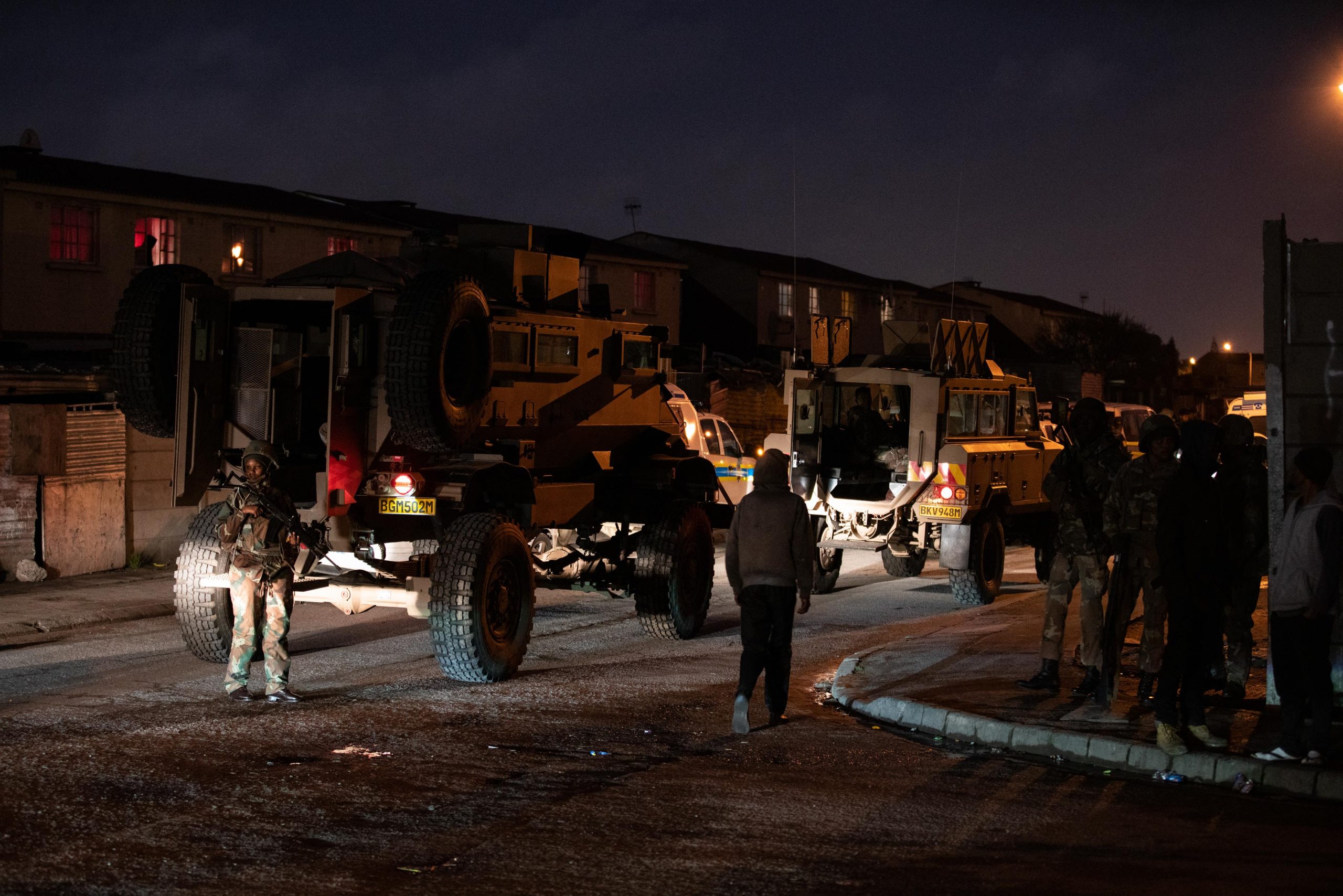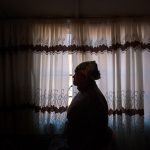Mixed emotions as soldiers return to the Cape Flats
Police Minister Bheki Cele made good on his week-old promise to send the SANDF to the Cape Flats to secure the area while the police searched and raided in an attempt to clamp down on gang violence…
Author:
22 July 2019

Amanda Davids remembers the last time she saw soldiers on the streets of Bishop Lavis, on the Cape Flats in Cape Town. It was 1989 and she was a feisty 12-year-old.
Fed up with the way history was taught at school, she delved into the books her older brother – an activist in the Pan Africanist Congress of Azania (PAC) – read and became one of the youngsters who faced off against soldiers during the violent period of apartheid’s final state of emergency.
The memory hurts. Thirty years later, the chilling fear of men dressed in brown army fatigues still haunts Davids.
“When we saw them, they started shooting at us. It used to be tear gas or rubber bullets, and then whoever they could catch was thrown into the back of that casspir. You drove around all day with them and they would hit you. They would drop you wherever after a couple of hours and you would not know where you are or who you are,” Davids says.
Related article:
The 42-year-old is still an activist. She is a member of an organisation called the Bishop Lavis Action Community (Blac), which is at the forefront of anti-gang projects in the Bishop Lavis area near Cape Town International Airport.
On 18 July, Davids relived the fear she felt all those years ago. In the late wintry afternoon, the soldiers arrived.
Casspirs slowly roamed the streets of Hanover Park and Manenberg, while groups of soldiers standing in armoured vehicles wove their way between the cramped council-owned blocks of flats. As the soldiers left the big carriers to guard the area with R4 rifles held across their chests, the police searched and raided.
The promise Police Minister Bheki Cele had made just a week earlier had been delivered. Soldiers were deployed as a force multiplier – in this case, additional personnel to increase the effectiveness of police work – to assist officers in their fight against gangsterism on the Cape Flats.
As they drove in their big vehicles, groups of children ran after them shouting their joy. The streets were full of onlookers. A young man yelled desperately at the passing men with guns: “Look after us, don’t go!”
They were welcomed like heroes.

The force multiplier
It’s called Operation Prosper and it is the first time that soldiers have been seen on the Cape Flats since Operation Fiela in 2015. Bishops Lavis is one of 10 police precincts with the highest rates of murder in the Western Cape where soldiers will be deployed.
Just a year ago, Cele declared that the army would not be deployed to the Cape Flats. Publicly, he has said that one of the reasons behind his change of mind is sustained pressure from community policing forum (CPF) members. It led to engagement between the police ministry, defence ministry and presidency, until President Cyril Ramaphosa agreed to give the go-ahead.
“Let us be clear that the SANDF is not the defence force of old. It is not the defence force of the apartheid time, which used young people as targets for shooting,” Ramaphosa said in his budget speech on 18 July.
“This is the defence force of a democratic South Africa, a defence force that has been involved in peacekeeping operations in various parts of the continent, and which has played a critical supportive role supporting the South African Police in similar crime-fighting operations.”
Ramaphosa told Parliament that the total expenditure for the deployment is R23,391,351. He added that 1,320 soldiers have been employed for Operation Prosper. While Cele has said the soldiers would be deployed until October, Ramaphosa told the House that they would leave in September.
Related article:
It started in a meeting room behind the Athlone Police Station. There were CPF volunteers from eight different police stations that are collectively known as the Mitchell’s Plain cluster. The volunteers spent weeks and months in this room, where they caucused. Their frustration grew at the number of killings and lack of police resources.
They went to all spheres of government and were dissatisfied at the lack of progress to stop the murders and the flow of illegal guns to gangsters. In a precedent-setting move, they broke police regulations to host a press conference at which they demanded that the army be deployed. The army, they said, is the only viable force multiplier to bring peace.
“They are the force multiplier. They can bring stability,” said Abie Isaacs, who is the chairperson of the Mitchell’s Plain CPF.
Cele has given this group of CPF members what they asked for. The army has been deployed to assist the police in a joint operation and has not, so far, been involved in any policing work. But while the Mitchell’s Plain CPF cluster is confident that this move will stem the violence so that deeper solutions to inequality and unemployment can be found, some fear that the deployment of the SANDF might be a terrible mistake.
The murder capital
Dumisani Qwebe has had a tough job. He is the secretary of the CPF in Nyanga, which is commonly referred to as the “murder capital” of South Africa. According to 2018 crime statistics, 308 murders were reported at the Nyanga Police Station alone.
Qwebe has heard the calls of his neighbours on the Cape Flats. But as he sits at home waiting for the soldiers to arrive, he says the army should never have been deployed.
“For us in Nyanga, it was not a good idea. But we can’t do anything because it’s already on the table,” he says.
In Cape Town, it’s no coincidence that gangsterism is most active in areas of the Cape Flats where high rates of unemployment, poverty and a lack of housing provide opportunities for gangsterism to thrive.
Related article:
Khalil Goga, a former research consultant at the Institute for Security Studies, wrote in one research paper that: “The majority of the informal [shack] settlements and suburbs surrounding the city lack many fundamental elements, making them increasingly dysfunctional and rife for the infiltration of organised crime.”
The paper details how a legacy of inequality in the city has made it easy for gangsters to exploit vulnerable communities by providing housing and services that buys them turf and support in the neighbourhoods in which they operate.
Qwebe says that for people in Nyanga to get rid of gangsterism, there must be more opportunities and a better quality of life for the young people who are most impacted.
“We were expecting that we need to have all the government departments on board because what is happening here is a social challenge problem,” he says.
His sentiment is echoed by Shamielah Edwards. Over the past month, the 61-year-old has been a member of a sustained campaign, known as Take Back Our Streets, to reclaim Manenberg from gangsters through occupying parks in the area and picketing outside Parliament.
“If they are there, then we want them to help the police and not shoot. We are not going to stop with our marches, we are not going to stop occupying the parks,” Edwards said.
She remembers a time, during Operation Fiela, when the presence of soldiers led to escalated violence. “The shootings that took place at the bottom of Manenberg at that time, we weren’t happy. They shoot to kill.”
Those who were raided
Just a few hours after Cele announced on 11 July that the army would be deployed, the police were being prepared for a large-scale operation in Lower Crossroads, which neighbours Philippi East. In recent weeks the area has become synonymous with mass killings, with 13 people dead in one weekend.
At 3am on Friday 12 July, in the sparsely lit streets of one of the most dangerous areas in Cape Town, police officers banged on doors and searched homes as they made their way through the streets of the neighbourhood.
The South African Police Service has not responded to requests about how many arrests were made or if any illegal weapons or drugs were confiscated. According to Western Cape Premier Alan Winde, 143 arrests were made that weekend in areas around the Cape Flats.
But 43 people were also killed. Provincial Forensic Services gathered the data between the night of Friday, 12 July and the morning of Monday, 15 July, and the DA-led provincial government released the figures.
“We welcome the fact that 143 arrests were made, and guns and drugs confiscated. But despite this heavier police presence and [Police] Minister Bheki Cele himself going out on patrol, 43 people were still murdered, some of them in the very areas where the operation was held,” said Winde.

Raids and fear
As the raid went on in Lower Crossroads, those who were searched and where nothing was found were left shocked and frustrated. “I’m not feeling well, I’m so scared. Every time I leave work late at night, I pray, ‘Please can I get safe home.’
I thought that they [the police] were the gangsters coming here,” said one mother whose home was raided.
On Thursday 18 July, the SANDF stood watch, securing the grounds as the police raided blocks of flats in Manenberg and Hanover Park. New Frame witnessed one arrest in Hanover Park, but detailed figures relating to the raids have yet to be released. As neighbours watched the police move between homes, there was hope that the soldiers would bring more calm.
“There’s light in the tunnel. Our people, you can see, they are safe now in the area,” one onlooker said, despite just having watched the police kick down the door of the neighbour who lives opposite him. “They mustn’t abuse this … that guy is disabled. I mean to do that to the door is unnecessary.”
The army left Hanover Park before 8pm. While they were in the area with police, there was no gunfire from the gangs. But as their vehicles retreated from Hanover Park and Manenberg, there was no telling what would happen once the force multiplier had disappeared from view and the gangsters remained behind.



